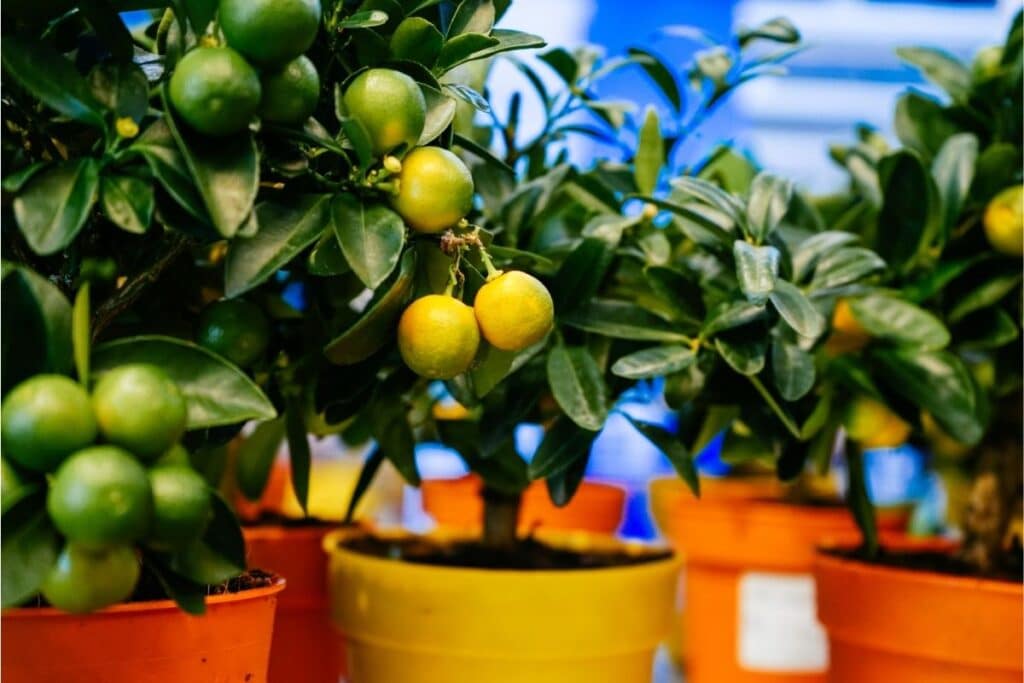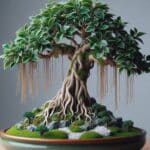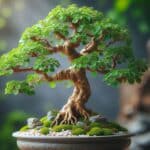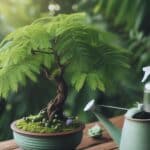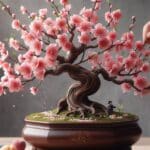If you’re going to grow a bonsai lemon tree, you’ll have the best luck growing one that’s already trained to grow in a compact fashion – and that’s geared toward indoor growers. The Meyer lemon tree, or Citrus × meyeri, is the best option.
Some other names you might hear for this plant include Improved Meyer Lemon, Chinese Dwarf Lemon, Dwarf Lemon, and Chinese Dwarf Lemon.
Always beautiful, this plant offers interest and appeal even when it’s not loaded with fruits (that’s right – even when grown as a bonsai, your lemon tree can still produce tasty fruit for you!). It has dark green leaves with fragrant fruits and a gorgeous array of purple or white flowers.
The Meyer lemon offers a flavor that is sweeter than a true lemon, similar to that of a Mandarin orange. The lemon is a bit darker than what you’d find on a “traditional” lemon tree, too.
Growing a lemon tree bonsai is easy – here is what you need to know.
Interesting Facts about Bonsai Lemon Tree
| Height | 14-18” |
| Width | 4-6” |
| Sunlight | Full sunlight |
| Flowering Time Length | Spring |
| Lifespan | 50 years |
| Scientific Name | Citrus × meyeri |
Growing Lemon Tree Bonsai from Seed or by Propagation
The bonsai lemon plant can be propagated by both seeds and cuttings. Air layering is another technique you can use. In most cases, it’s easiest to purchase a plant that has already been started from a specialty bonsai dealer, since it will already have been trained to grow in a container.
Lemon Bonsai Care Guide
Soil
Lemon bonsai trees thrive in well-draining soil that is slightly acidic with a pH level between 5.5 and 6.5. A mixture of equal parts peat moss, perlite, and pine bark fines provides the ideal growing medium. This combination ensures adequate drainage holes to prevent waterlogged roots while retaining moisture and nutrients essential for healthy growth.
Additionally, incorporating organic matter, such as compost or aged manure, can enrich the soil and promote nutrient uptake. Regular soil moisture levels and pH balance monitoring are crucial to maintaining optimal growing conditions for lemon bonsai trees.
Sunlight
Citrus trees, when grown outdoors, thrive best in USDA Zones 8B-10. As you can see, they love the heat. They require full sun to bloom and fruit reliably, but they can tolerate some shade if that’s what you have. In regions with a warm climate, citrus trees flourish, benefiting from the abundant sunlight and warmth.
Grow lights can be a great solution for indoor citrus trees, especially if you live in an area with little natural light. These lights provide a controlled light spectrum, ensuring your indoor citrus trees receive the right amount of light to thrive. You can extend the growing season for your indoor citrus trees by using grow lights.
Watering
You can water your citrus tree regularly in the summer but do keep in mind that it can handle occasional periods of dryness. It is better for this plant to be slightly dry than it is for it to be overly wet. If your soil is well-draining, just water when the surface of the soil is dry. Try to use water that has not been treated, as the plant prefers water that is free from lime.
Fertilizing
Use a special liquid fertilizer, ideally one that is designed for citrus plants, about once every two weeks. This can be done regularly from spring until fall, but in the winter, you will need to slow to just once per month. Consider diluting the fertilizer to half strength to avoid overdosing your plants.
Potting and Repotting
You may repot your lemon once every two to three years, ideally by using the technique of root pruning. When you repot, use a slightly acidic soil mixture, like peat, to provide your bonsai with the nutrients it needs.
Pruning Bonsai Lemon Tree
Your bonsai can be pruned back, with shoots cut to leave just two leaves, after a total of four leaves have grown. Prune regularly after this time, as this will help your lemon bonsai trees remain healthy and adapted to growing in a container. It can also help improve the quality of blooms and fruit set.
When pruning, pay attention to the root mass as well. A well-maintained root system is crucial for the overall health and vigor of your bonsai. Ensure that the roots are not overly crowded or circling the container. If necessary, consider root pruning during repotting to maintain a balanced and healthy root structure.
You can also wire your lemon bonsai tree, but make sure the wires don’t cut into the bark. You may need to use guy wires instead to shape your tree.
Pests and Diseases
The bonsai lemon tree is prone to many of the same pests and diseases that might plague outdoor-grown plants. Some of the most common include aphids, fruit tree red spider mite, caterpillars, glasshouse red spider mites, scale insects, and mealybugs.
These pests are significantly more common when you grow your plant in a low-light condition with too much heat. Improve the growing conditions and treat with a pest-specific pesticide in order to get rid of these bugs.
Where to Buy Bonsai Lemon Tree
Consider purchasing your lemon tree bonsai from a dealer that specializes in these plants. Although you can buy a regular lemon tree and simply train it to grow in a small container, this may not provide you with their results you’d like, or as quickly.
FAQs
Can I turn a lemon tree into a bonsai?
Yes, you can turn a lemon tree into a bonsai. Lemon trees can be trained and pruned to create the miniature size and aesthetic characteristic of bonsai trees.
How do you take care of a citrus bonsai tree?
To take care of a citrus bonsai tree, ensure it receives plenty of sunlight, ideally at least 6-8 hours per day. Water the tree when the top layer of soil feels dry, but avoid overwatering as citrus trees are sensitive to waterlogged soil. Fertilize regularly during the growing season with a balanced fertilizer formulated for citrus trees.
What is the best soil for lemon bonsai?
The best soil for lemon bonsai trees is a well-draining mix that retains moisture without becoming waterlogged. A mix of bonsai soil, organic matter like compost, and inorganic material like perlite or grit can provide the ideal balance of drainage and moisture retention.
Check our other guides about orange bonsai tree, Kumquat bonsai tree, fruit tree bonsai and other bonsai types.
*image by mne_len/depositphotos

